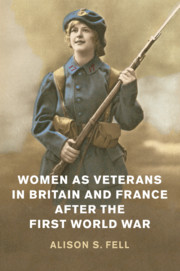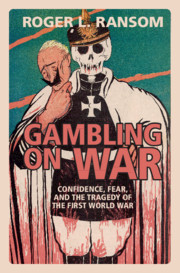Refine search
Actions for selected content:
15418 results in Military history
Dedication
-
- Book:
- Gambling on War
- Published online:
- 21 June 2018
- Print publication:
- 28 June 2018, pp v-vi
-
- Chapter
- Export citation
8 - The Chaos of Victory
-
- Book:
- Gambling on War
- Published online:
- 21 June 2018
- Print publication:
- 28 June 2018, pp 233-269
-
- Chapter
- Export citation
Notes
-
- Book:
- At War's Summit
- Published online:
- 15 June 2018
- Print publication:
- 28 June 2018, pp 350-418
-
- Chapter
- Export citation
3 - First Battle Tests and the Handicaps of Selective Learning
-
- Book:
- At War's Summit
- Published online:
- 15 June 2018
- Print publication:
- 28 June 2018, pp 64-93
-
- Chapter
- Export citation
Epilogue: The Tragedy of a World War
-
- Book:
- Gambling on War
- Published online:
- 21 June 2018
- Print publication:
- 28 June 2018, pp 270-272
-
- Chapter
- Export citation
4 - Contest of Follies: Plan Edelweiss and the German Offensive Across the High Caucasus
-
- Book:
- At War's Summit
- Published online:
- 15 June 2018
- Print publication:
- 28 June 2018, pp 94-134
-
- Chapter
- Export citation
Copyright page
-
- Book:
- At War's Summit
- Published online:
- 15 June 2018
- Print publication:
- 28 June 2018, pp iv-iv
-
- Chapter
- Export citation
Tables
-
- Book:
- Gambling on War
- Published online:
- 21 June 2018
- Print publication:
- 28 June 2018, pp x-x
-
- Chapter
- Export citation
Bibliography
-
- Book:
- At War's Summit
- Published online:
- 15 June 2018
- Print publication:
- 28 June 2018, pp 419-427
-
- Chapter
- Export citation
3 - Schlieffen’s Gamble
-
- Book:
- Gambling on War
- Published online:
- 21 June 2018
- Print publication:
- 28 June 2018, pp 51-84
-
- Chapter
- Export citation
Acknowledgements
-
- Book:
- At War's Summit
- Published online:
- 15 June 2018
- Print publication:
- 28 June 2018, pp 348-349
-
- Chapter
- Export citation
Notes
-
- Book:
- Gambling on War
- Published online:
- 21 June 2018
- Print publication:
- 28 June 2018, pp 288-311
-
- Chapter
- Export citation
Tables
-
- Book:
- At War's Summit
- Published online:
- 15 June 2018
- Print publication:
- 28 June 2018, pp xiv-xiv
-
- Chapter
- Export citation
5 - Economies at War
-
- Book:
- Gambling on War
- Published online:
- 21 June 2018
- Print publication:
- 28 June 2018, pp 118-153
-
- Chapter
- Export citation
Dedication
-
- Book:
- At War's Summit
- Published online:
- 15 June 2018
- Print publication:
- 28 June 2018, pp v-vi
-
- Chapter
- Export citation
2 - Otto von Bismarck and the Changing Paradigm of War
-
- Book:
- Gambling on War
- Published online:
- 21 June 2018
- Print publication:
- 28 June 2018, pp 33-50
-
- Chapter
- Export citation
Figures
-
- Book:
- At War's Summit
- Published online:
- 15 June 2018
- Print publication:
- 28 June 2018, pp ix-xi
-
- Chapter
- Export citation
Contents
-
- Book:
- Gambling on War
- Published online:
- 21 June 2018
- Print publication:
- 28 June 2018, pp vii-vii
-
- Chapter
- Export citation

Women as Veterans in Britain and France after the First World War
-
- Published online:
- 23 June 2018
- Print publication:
- 12 July 2018

Gambling on War
- Confidence, Fear, and the Tragedy of the First World War
-
- Published online:
- 21 June 2018
- Print publication:
- 28 June 2018
